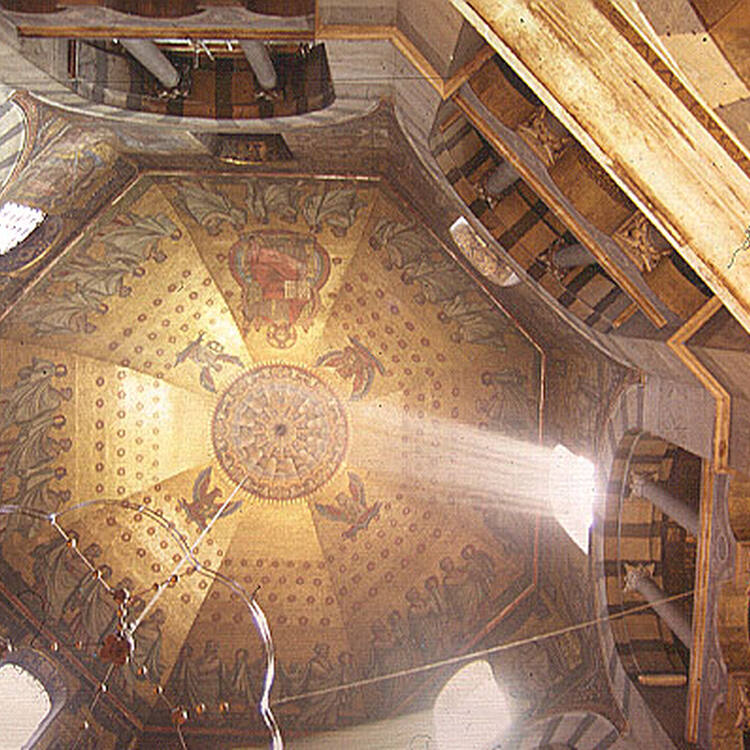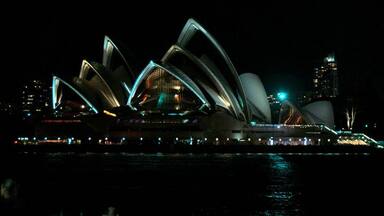Aachen Cathedral
Aachen Cathedral
Construction of this palatine chapel, with its octagonal basilica and cupola, began c. 790–800 under the Emperor Charlemagne. Originally inspired by the churches of the Eastern part of the Holy Roman Empire, it was splendidly enlarged in the Middle Ages.
Description is available under license CC-BY-SA IGO 3.0
Cathédrale d'Aix-la-Chapelle
C'est de 790 à 800 environ que l'empereur Charlemagne entreprit la construction de la chapelle Palatine, basilique octogonale à coupole, imitée des églises de l'Empire romain d'Orient et ornée de précieuses adjonctions datant de l'époque médiévale.
Description is available under license CC-BY-SA IGO 3.0
كاتدرائية آخن
شيّد الأمبراطور شارلمان كنيسة بالاتين بين العامين 790 و 800 وهي بازيليك مثمنة الأطراف ذات قبّة، تُعتبر نسخة عن كنائس الإمبراطورية الرومانية الشرقية تزينها زخارف ثمينة للغاية تعود إلى القرون الوسطى.
source: UNESCO/CPE
Description is available under license CC-BY-SA IGO 3.0
亚琛大教堂
这座宫殿式教堂整体结构呈长方形,屋顶为拱形,修建于约公元790至800年查理曼大帝执政时期。建造这座教堂的灵感来源于东罗马帝国的教堂,在中世纪又对其进行了扩建。
source: UNESCO/CPE
Description is available under license CC-BY-SA IGO 3.0
Кафедральный собор в городе Ахен
Строительство Дворцовой капеллы, с базиликой и восьмигранным куполом, началось между 790 и 800 гг. во время правления императора Карла Великого. Первоначально выстроенная по образцам церквей Восточно-Римской империи, капелла приобрела еше более роскошный вид при расширении в Средние века.
source: UNESCO/CPE
Description is available under license CC-BY-SA IGO 3.0
Catedral de Aquisgrán
La construcción de esta capilla palatina en forma de basílica octogonal rematada por una cúpula comenzó entre los años 790 y 800, en tiempos del emperador Carlomagno. Es una imitación de las iglesias del Imperio Romano de Oriente y en la Edad Media se le agregaron revestimientos espléndidos.
source: UNESCO/CPE
Description is available under license CC-BY-SA IGO 3.0
アーヘン大聖堂
source: NFUAJ
Dom van Aken
Source: unesco.nl
Outstanding Universal Value
Brief synthesis
It is Emperor Charlemagne´s own Palatine Chapel, which constitutes the nucleus of the Cathedral of Aachen, located in western Germany. The construction of the chapel between 793 and 813 symbolises the unification of the West and its spiritual and political revival under the aegis of Charlemagne. Originally inspired by the churches of the eastern part of the Holy Roman Empire, the octagonal core was splendidly enlarged in the Middle Ages. In 814, Charlemagne was buried here.
Charlemagne made the Frankish royal estate of Aachen, which had been serving a spa ever since the first century, his favourite abode. The main buildings of the Imperial Palace area were the Coronation Hall (aula regia – located in today´s Town Hall) and the Palace Chapel – now Aachen Cathedral. The Palatine Chapel is based on an octagonal ground plan, which is surrounded by an aisle and by tribunes above, and roofed with a dome. Facing the altar, the Emperor sat on the gallery; the Carolingian stone throne was the coronation seat of the kings of the Holy Roman Empire of German Nation from the Middle Ages until 1531. The chapel itself is easily recognizable from later additions by its distinctive structure. An atrium on the western side and a portico led to the imperial apartments. The Gothic choir and a series of chapels that were added throughout the Middle Ages created the composite array of features that characterised the cathedral.
The interior is punctuated on the lower storey by round arches set upon eight ample pillars, and on the upper storey by a gallery with eight Carolingian bronze gates. The high dome gathers light from eight open-arched windows above the drum; it was originally entirely covered with a large mosaic depicting Christ Enthroned, in purple robes and surrounded by the Elders of the Apocalypse. The present-day mosaic dates back to 1880/1881. The interior of the chapel is embellished by antique columns that Charlemagne probably ordered to be brought from Rome and Ravenna. Despite the subsequent additions, the Palatine Chapel constitutes a homogeneous nucleus.
The Cathedral Treasury in Aachen is regarded as one of the most important ecclesiastical treasuries in northern Europe; the most prominent inventory items are the cross of Lothar (about 1000 AD), made from gold and inlaid with precious stones, the dark-blue velvet chasuble with embroidered pearls, a reliquary-bust of Charlemagne made from silver and gold, and a marble sarcophagus decorated with a relief of the Abduction of Proserpine, which once contained the body of Charlemagne.
Criterion (i): With its columns of Greek and Italian marble, its bronze doors, the largest mosaic of its dome (now destroyed), the Palatine Chapel of Aachen, from its inception, has been perceived as an exceptional artistic creation. It was the first vaulted structure north of the Alps since Antiquity.
Criterion (ii): Bearing the strong imprint of both Classic and Byzantine tradition this chapel remained, during the Carolingian Renaissance and even at the beginning of the medieval period, one of the prototypes of religious architecture which inspired copies or imitations.
Criterion (iv): The Palatine Chapel of Charlemagne is an excellent and distinctive example of the family of aulian chapels based on a central plan with tribunes.
Criterion (vi): The construction of the Chapel of the Emperor at Aachen symbolised the unification of the West and its spiritual and political revival under the aegis of Charlemagne. In 814, Charlemagne was buried here, and throughout the Middle Ages until 1531, the German emperors continued to be crowned at Aachen. The collection of the treasury of the Cathedral is of inestimable archaeological, aesthetic and historic interest.
Integrity
Aachen Cathedral contains all the elements necessary to express the Outstanding Universal Value and is of appropriate size. All features and structures to convey its significance as Emperor Charlemagne´s own Palatine Chapel are present.
Authenticity
Form and design, material and substance, use and function as church and most important pilgrimage site north of the Alps have remained unchanged.
Protection and management requirements
The Cathedral of Aachen is a listed monument according to paragraphs 2 and 3 of the Act on the Protection and Conservation of Monuments in the State of North Rhine-Westphalia, dated 11 March 1980 (Protection Law). Conservation and building activities within and outside the property are regulated by paragraph 9 (2) Protection Law and Local Building Plans.
The proposed buffer zone is protected as Monument Protection Area according to paragraph 5 of the Act on the Protection and Conservation of Monuments. The property is managed by the Cathedral Construction Administration (Dombauleitung) under the responsibility of the Cathedral Chapter. They act in concertation with the regional and local historic monument conservation authorities, via the property’s Steering Committee (Dombaukommission), which exercises authority with regard to project control and coordination between the various partners involved. The management system consists of a set of maintenance and conservation measures which is annually reviewed and updated when required by the Steering Committee.

